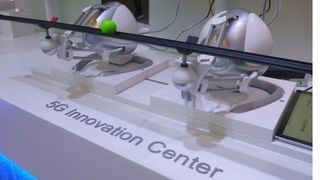How 5G will radically change the Internet of Things
Ultra-fast networks can't come soon enough for the IoT

You loved 3G and eventually migrated to 4G, but does 5G get you excited? It probably doesn't. After all, who needs to send a SnapChat, a tweet, an SMS or an email any faster than is already possible?
That's not stopping the mobile industry hyping up 5G, which could be in place as early as 2018, and be fully commercialised by 2020. But the 10 to 100 times expected increases in network speeds isn't what operators are getting excited about. Instead, it's the near-instant sending and receiving of data that 5G will enable that could prove a huge enabler of new technology – and a massive fillip to the Internet of Things.

5G in our pockets
But what do you do with a mobile signal that's 100 times faster than the 4G network? "Everyone is using their smartphones and the internet," says Daisuke Kurita, Researcher for the 5G Radio Access Network Research Group at mobile network operator NTT DoCoMo in Japan. "So we need 5G for capacity, and people need more speed for 4K video."
This is 5G's first and most obvious technology – eMBB (enhanced Mobile Broadband) – and for most of us, 5G's gigabit-per-second speeds will make it easier to download, stream and share Ultra HD quality videos, which smartphones like the iPhone 6S, Samsung Galaxy S7 and LG G5 can increasingly produce video in.
Although virtual reality and 360-degree video streams are just as likely to prove a hit. Cisco reckons that video will jump 16% to account for 80% of all mobile data traffic by 2021, fuelled by 5G's ability to download an 8GB movie in just a few seconds.
But with such small phone screens, that's hardly a killer app or a catalyst for global take-up of 5G – and it's not why the likes of Intel, Qualcomm, Samsung, AT&T, T-Mobile, Ericsson, Nokia, SK Telecom, NTT DoCoMo, Cisco, Vodafone and China Mobile are beginning pre-trials this year.

Low-latency and 'cloud robots'
Forget video and the Internet of Phones – it's behind the scenes in the Industrial Internet of Things (IIoT, also known as 'Industry 4.0') that 5G will have the biggest effect. At Mobile World Congress last month, Nokia and China Mobile showed off 5G-enabled 'co-operative cloud robots', which use 5G's enhanced speeds for exchanging video streams, but also a second, critical technology: URLLC (Ultra-Reliable and Low Latency Communications).
Are you a pro? Subscribe to our newsletter
Sign up to the TechRadar Pro newsletter to get all the top news, opinion, features and guidance your business needs to succeed!
"Humans can't tell the difference between one or two milliseconds, but robots can," says Sándor Jordan, Software Researcher (5G) at Nokia Bell Labs, while demoing a couple of robots linked to the same mobile edge cloud. Each robot 'held' one end of a platform, constantly uploading and analysing video to balance a ball.
"The latency is so low that you can put some intelligence in the cloud," says Jordan, who thinks the same technology could be used for fully automated manufacturing, and logistics. He even thinks it could be used to keep future delivery drones balanced as they deliver packages.

The Internet of Cars
Send an SMS on a 4G network and it will take at least 40 milliseconds. Do it on 5G and it takes one or two milliseconds. 5G's low latency characteristic is all about safety. Think heavy manufacturing robots in car factories that can react lightning-quick to safety issues. However, the 'killer app' is probably the autonomous car and its dealings with the cloud, and with other self-driving vehicles. In fact, it's hard to imagine them without 5G.
Again, it's the lack of latency that's critical. Calling it "a perfect use-case for 5G", Ralph de la Vega, vice chairman of AT&T Inc. and CEO of AT&T Business and AT&T International, told techradar pro that he thinks only 5G will allow a driverless car to respond to a red light, or exchange data with a nearby vehicle to help avoid a collision.
"That exchange of information is critically important for autonomous cars," he says, noting that while a fridge might not need 5G, autonomous cars will. "These autonomous cars will all be connected, and they will require high speed and low latency."
He's right, but there would have to be some kind of network priority in place – a car that's using 5G to avoid a collision couldn't risk having its data exchanges interrupted when passing a packed stadium with 80,000 people clogging up the same mobile mast.
Want to find out more about 5G? Check out our dedicated 5G hub!
Jamie is a freelance tech, travel and space journalist based in the UK. He’s been writing regularly for Techradar since it was launched in 2008 and also writes regularly for Forbes, The Telegraph, the South China Morning Post, Sky & Telescope and the Sky At Night magazine as well as other Future titles T3, Digital Camera World, All About Space and Space.com. He also edits two of his own websites, TravGear.com and WhenIsTheNextEclipse.com that reflect his obsession with travel gear and solar eclipse travel. He is the author of A Stargazing Program For Beginners (Springer, 2015),
Most Popular


